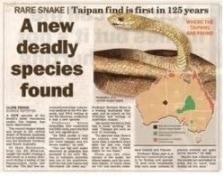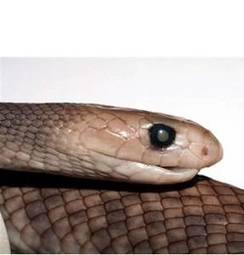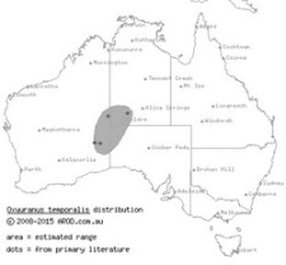Central Ranges TaipanOxyuranus temporalis |

Custom Search
|
|
The Central Ranges Taipan (Oxyuranus temporalis), is a recently discovered species of taipan. The new snake species was found and described in 2007 by Australian researchers, and is a large, fast and highly venomous Australian snake.
The central ranges taipan discovery was a complete surprise since the other two species of taipan aren't found in that sandy desert habitat.This was the first new taipan snake species to be discovered in 125 years. Further studies and phylogenetic analysis of its DNA sequences showed it to be the sister species of the 2 previously known taipans. The Central Ranges taipan differs from the other 2 taipan species, the inland taipan (Oxyuranus microlepidotus) and the coastal taipan (Oxyuranus scutellatus), because it lacks a temporal labial scale and has 6, not 7 infralabial scales. The taipan snake species are considered some of the most venomous land snakes in the world. In fact, the inland taipan is regarded as the most venomous of all and the coastal taipan as the 3rd most venomous after the eastern brown (Pseudonaja textilis). It is probable that the new species, the Central Ranges taipan is also highly venomous given its close relationship to the other 2 previously known taipan species. The fist specimen caught in 2007 was nicknamed "Scully" after the X-Files TV character. It was an immature snake measuring about 3 ft (1 m), this means that scientists don't know the species adult size, although some taipans can reach a total length of about 10 ft (3 m).

In early 2010, a second specimen was found, it was an adult female measuring 4.3 ft (1.3 m) and was captured by the Spinifex people, 425 kilometers south of the location of the initial discovery.
Because there are only 5 recorded specimens so far, with only 2 being kept in captivity, very little is known of its natural history, feeding and reproduction habits, or its venom. But the species seems to be widespread, its specimens were found several hundred kilometers apart from each other. The areas in which this species was found are extremely remote and belong to Aboriginal Reserves, that are only accessible with special permits. Diet / Feeding Because the Central Ranges taipan is a recently discovered species, no information is available on their feeding habits. But we can assume that it probably feeds on rodents and small mammals like their cousin species. Reproduction Since this is a newly discovered species, no information is available on their reproduction. Conservation / Threats The species new conservation status has yet to be assessed by the IUCN Red List, as the data available is not sufficient.
|
Did You Know?
A group of snakes is called a bed, den, pit or nest, find more interesting facts about snakes for kids. Scientific classification |
© 2014 Snake Facts About Us | Privacy Policy | Contact






